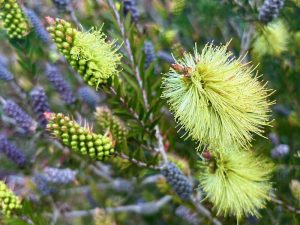Melaleuca pallida — Nectar-Rich Lemon Bottlebrush for Coastal and Mediterranean Gardens
Melaleuca pallida, or Callistemon pallidus, (commonly called Lemon Bottlebrush) is an upright, nectar-rich shrub or small tree in the Myrtle family (Myrtaceae). It produces abundant pale yellow to cream bottlebrush flowers in late spring and summer. The blossoms attract honeyeaters and other pollinators and give way to woody seed capsules that persist on the stems. The species was previously known as Callistemon pallidus, and you will still see that name in many horticultural sources, but most modern taxonomies accept Melaleuca pallida as the correct name.
Taxonomists revised the classification in the 2000s after DNA studies showed Callistemon fits within the broader Melaleuca lineage. Lyndley Craven’s 2006 treatment formalised many name changes, so Callistemon pallidus generally appears today as Melaleuca pallida. Some regional herbaria and nurseries still use the older name. Practically speaking, both names are useful for searching older references and nursery stock. The common name “Lemon Bottlebrush” remains familiar and descriptive.
Melaleuca pallida description and growth habit
Melaleuca pallida or Callistemon pallidus (Lemon Bottlebrush) grows as an evergreen shrub or small tree. In cultivation it typically reaches about 2–3 m (6.5–10 ft) tall and 2–3 m (6.5–10 ft) wide, though in the wild or optimal conditions it can grow as tall as 8 m (26 ft). The plant produces thin, spreading branches and new growth that often shows a pinkish tinge and silky hairs. Mature leaves are narrow-elliptic to egg-shaped, 20–79 mm (0.8–3 in) long and 4–17 mm (0.2–0.7 in) wide, grey-green in color with visible oil glands. The bark ranges from fibrous to papery, adding winter interest.
Flowers appear in dense cylindrical spikes (the classic “bottlebrush”) that measure roughly 20–45 mm (0.8–2 in) in diameter and 50–100 mm (2–4 in) long on terminal or lateral stems. Individual flowers have numerous stamens (34–70), which create the brush effect and supply abundant nectar. Flower color ranges from creamy yellow to pale lemon; occasionally flowers show a pinkish flush. Flowering occurs primarily from October to February in Australia (late spring to mid-summer), but in other climates the peak will reflect local seasons.
Why gardeners grow Melaleuca pallida
This plant brings four things gardens want: long bloom displays, nectar for birds, low maintenance, and attractive foliage. It suits coastal sites, Mediterranean-style planting, wildlife gardens, and mixed shrub borders. It tolerates wind and moderate frost, and once established it handles dry spells. Use it as a specimen, informal screen, or hedge. The persistent woody fruit add texture and interest through winter.
How to grow Melaleuca pallida
Plant it with care and it will reward you for years.
Light
Place it in full sun for best flowering. Aim for at least 6 hours of direct sunlight a day. In hot inland climates a little afternoon shade reduces stress and can extend bloom quality.
Soil
Plant it in well-drained soil. It thrives in acidic to neutral soils but adapts to a broad range of textures from sandy loam to light clay if drainage is good. Amend heavy soil with compost and coarse sand to improve structure. If you garden in pots, use a free-draining potting mix and a container with drainage holes.
Watering
Water newly planted shrubs deeply once or twice a week for the first season to establish roots. Thereafter, water infrequently but deeply; established plants are drought tolerant and need irrigation every two to three weeks in prolonged dry spells. Avoid waterlogging — root rot can occur in poorly drained soils.
Fertilizing
Feed it lightly in spring with an organic slow-release fertiliser or a low-phosphorus native plant feed suited to Myrtaceae. Avoid high-phosphorus feeds; Australian natives and related species do poorly with heavy phosphorus applications. Top-dress with compost each spring to maintain soil fertility.
Temperature and humidity
This species adapts to temperate and warm climates. It performs well in USDA hardiness roughly equivalent to zones 8b–11 (mild frost tolerance) but will tolerate colder pockets in sheltered sites. Avoid planting in persistently humid, shaded areas where fungal issues may become more likely.
Planting steps
Plant it in a hole twice the width of the root ball and set the crown level with the surrounding soil. Backfill with existing soil mixed with compost. Water in deeply. Mulch the root zone with 5–7.5 cm (2–3 in) of organic mulch, keeping mulch away from direct bark contact to avoid collar rot.
Pruning and maintenance
Prune lightly after flowering to shape and encourage bushier growth. Remove crossing, dead, or diseased branches as needed. Avoid hard pruning into old wood because heavy cutting back can reduce next season’s flower display. Regular light shaping keeps the plant dense and attractive.
Propagation of Melaleuca pallida
Propagate by seed or cuttings depending on your goals.
- Seed: Collect mature woody capsules and dry them until they release fine seeds. Sow onto moist, well-draining seed mix at roughly 16–18°C (61–64°F) in spring. Germination is usually quick; accept that seedlings grown from seed may vary from the parent in garden-grown strains.
- Cuttings: Take semi-ripe lateral cuttings in late summer. Use a clean, sharp knife and dip the cut end in rooting hormone. Place cuttings in a free-draining propagation mix, keep them shaded and moist, and expect roots to form in a few weeks. Cuttings produce true-to-type plants and are preferred for named forms.
Pests and diseases
Melaleuca pallida is generally robust and low on pest pressure, but you should still monitor it.
- Pests: Scale insects and mealybugs can occur, particularly in protected glasshouse conditions. Glasshouse red spider mite can show up on under-shelter plants. For small outbreaks use horticultural oil, insecticidal soap, or biological controls. Hand-scrubbing infested stems helps too.
- Diseases: Root rot can develop in waterlogged conditions. Powdery mildew is uncommon but possible where plants remain shaded and humid. Ensure good air circulation, avoid overhead watering, and remove infected tissue promptly.
- Deer and mammals: The plant is largely deer resistant, which suits suburban gardens with browsing pressure.
Flowering season, phenology and seed
Melaleuca pallida typically flowers in late spring and summer — October to February in the Southern Hemisphere. In cooler temperate climates you’ll see late spring to mid-summer blooms; in warmer zones flowering can extend longer or be less concentrated. The nectar-rich flowers attract honeyeaters, lorikeets, and native bees. After flowering the woody capsules develop and can persist on the stems for several seasons, slowly releasing seed when conditions trigger opening.
Environmental tolerances and site selection
This species tolerates a broad set of conditions:
- Drought tolerance: Good after establishment; occasional deep watering helps during long dry spells.
- Frost tolerance: Moderate; it tolerates light frost. In very cold regions give it a sheltered spot.
- Salt tolerance: Handles moderate coastal exposure and salt-laden winds.
- Wind: Performs well in exposed sites due to its flexible habit and tough foliage.
- Soil moisture: Prefers moist, well-drained soils; avoid heavy waterlogging.
Choose a site with sun, good drainage, and enough space for its mature size (roughly 2–3 m / 6.5–10 ft in a garden setting).
Design uses and companion planting
Use Melaleuca pallida as a specimen shrub, small screening hedgerow, or mixed shrub border. Its pale lemon flowers work well with silver-foliaged plants, grasses and drought-tolerant perennials. Consider these companion ideas:
- Pair with native grevilleas and callistemons for a bird-friendly native bed.
- Use with lavender, rosemary, and salvias in Mediterranean-style gardens where drainage is excellent.
- Combine with ornamental grasses (e.g., Pennisetum) to add movement and texture.
- Plant near paths, patios, or bird feeders to enjoy its nectar visitors up close.
Keep soil and fertilizer preferences in mind when choosing companions: many Myrtaceae prefer low-phosphorus soil.
Cultivars and selection
Cultivars from the former Callistemon group remain popular. Examples include ‘Austraflora Candle Glow’ and ‘Clearview Father Christmas’ (marketed under Callistemon pallidus names). These forms offer variations in habit and spike length. If you need faithful colour or size, choose plants propagated from cuttings rather than seed.
Practical tips for success
- Plant it in spring or autumn for best root establishment.
- Mulch after planting to conserve moisture, but keep mulch away from the trunk.
- Thin crowded branches in spring after flowering.
- Use a low-phosphorus fertiliser formulated for natives if you need to feed.
- Monitor under-shelter plants for sap-sucking pests and treat early.
Wildlife and ecological value
The nectar-dense bottlebrush spikes are magnets for nectar-feeding birds and pollinators. They serve as excellent food sources during peak flowering and provide shelter for small birds among the dense branches. The species supports local biodiversity and can form part of a native restoration or wildlife-friendly landscape.
Quick care summary
Plant Callistemon pallidus in full sun. Place it in well-drained soil. Water to establish, then water sparingly. Feed lightly in spring. Prune after flowering. Propagate via cuttings for cultivar fidelity. Expect reliable, nectar-rich blooms and low maintenance thereafter.
Final thoughts on Melaleuca pallida
Melaleuca pallida or Callistemon pallidus (Lemon Bottlebrush) offers year-after-year value: attractive foliage, long flowering displays, bird-attracting nectar, and low maintenance. It suits a wide range of garden styles from coastal and Mediterranean to native and cottage plantings. Plant it where you can enjoy the blooms and the birds it attracts, and treat it to a well-draining site with plenty of sun. With basic care and occasional pruning, it will reward you with strong seasonal interest and dependable performance.



